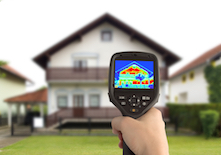
News
Codes and standards
FGIA releases new document for determining THERM finite element modeling surface temperatures
February 6, 2020 By FGIA
The Fenestration and Glazing Industry Alliance (FGIA) has released a new publication addressing aspects of the finite element (FE) thermal modeling process often used to predict interior surface temperatures on fenestration including non-residential windows, terrace and patio doors, curtain wall, storefront, and entrances. AAMA 515-19, “Voluntary Procedure for Determination of Fenestration Surface Temperatures by THERM Finite Element Modeling,” an FGIA standard, is now available for purchase in the FGIA online store.
Per AAMA 515, condensation will occur on any interior surface that falls below the dew point temperature of interior ambient air. Condensation can be unsightly, unsanitary, and over long periods of time, can damage adjacent building materials. This voluntary procedure helps designers determine what temperatures and film coefficients to use when running a project-specific condensation analysis.
 Designers often use two-dimensional finite element (FE) thermal modeling tools, such as Lawrence Berkeley National Laboratory’s (LBNL) THERM, to predict interior surface temperatures for standard or project-specific condor AAMA 501.9 thermal cycling tests of full-size mockups. For products with conductive framing, such as aluminum (with or without thermal barriers), caution is advisable in attempting to correlate FE modeling with testing, or in using FE modeling to predict variable test results.
Designers often use two-dimensional finite element (FE) thermal modeling tools, such as Lawrence Berkeley National Laboratory’s (LBNL) THERM, to predict interior surface temperatures for standard or project-specific condor AAMA 501.9 thermal cycling tests of full-size mockups. For products with conductive framing, such as aluminum (with or without thermal barriers), caution is advisable in attempting to correlate FE modeling with testing, or in using FE modeling to predict variable test results.
LBNL’s THERM software is widely used to predict temperatures. This voluntary procedure is intended to make application of the software tool uniform between users, and to address some of the issues which arise in surface temperature prediction and condensation assessment:
-
-
- Conflicting or confusing project specifications
- Model accuracy for aluminum framing
- Repeatability and reproducibility of modeling and testing
- Effects of substrates
- End-user expectations
-
“THERM software is widely used to predict surface temperatures of fenestration,” said Steve Fronek (Wausau Window and Wall Systems), chair of the Architectural Finite Element Thermal Modeling Task Group. “This new, voluntary procedure, a result of seven years of detailed development, is intended to make application of the software tool uniform between users. It addresses key variables, such as boundary conditions, substrates and THERM parameters, as well as the accuracy of modeling and testing. The scope is clearly outlined and guidance provided for the specifier.”
AAMA 515 outlines minimum requirements for FE thermal models used to predict surface temperatures of aluminum framing systems and is intended to be referenced in other industry standards, contract documents, proposals and marketing materials as needed.
AAMA 515-19, as well as other AAMA documents available from FGIA, may be purchased from the online store.
For more information
www.fgiaonline.org
Print this page
Leave a Reply